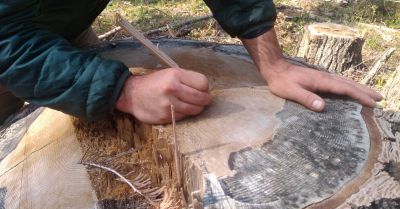Coalition sues Forest Service for sticking with Trump-era rollback of old growth protections in Oregon and Washington

Logging the Lostine: Remnants of a 2021 “public safety” thinning project along Oregon’s Lostine Wild and Scenic River Corridor. Photo: Oregon Wild
By Jordan Rane, June 21, 2022. One of the largest and most controversial rollbacks of old growth forest protection in the Columbia River Basin was enacted nearly a year and a half ago when, according to critics, much of the country was looking elsewhere.
Now a lawsuit against the U.S. Forest Service is bringing over 7 million acres of public forestland in eastern Oregon and southeast Washington back into the foreground.
On January 15, 2021, during the final days of the Trump administration, the USFS announced a rollback of the “Eastside Screens”—a 25-year-old land management regulation prohibiting the harvesting of any live tree with a trunk exceeding a 21-inch diameter at breast height throughout several public forests east of the Cascade Range.
MORE: Forest Service wants to eliminate protections on large trees
The USFS justified the amended protection as “a reassessment in light of current forest conditions.”
The ruling sparked protests from conservation organizations and vows of litigation if the policy reversals weren’t addressed by the incoming Biden administration.

Counting rings: Grand fir trees over 200 years old are being logged along the Lostine River in eastern Oregon. Photo: Greater Hells Canyon Council
Those promises have now been kept.
On June 14, a Notice of Intent was filed in federal court in Pendleton, Ore., by a coalition of six conservation organizations. The group is suing Biden administration officials for allowing discretionary logging of old growth forest in the Pacific Northwest.
The claim states the initial decision was politically motivated and that several federal laws have been broken—including violations of the National Environmental Protection Act and National Forest Management Act. The lawsuit also includes an intent to enforce Endangered Species Act protections for fish and wildlife dependent on old growth forest.
“We’re filing this lawsuit now because the threats are no longer an abstraction,” says Rob Klavins, northeast Oregon field coordinator for Oregon Wild. “We’re seeing the Forest Service continuing to develop projects that target these carbon giants across the region and abusing the discretion of the Trump screens.”
As an example, Klavins cites the Morgan Nesbitt Project, which has included proposals for near clear cuts in virgin forests extending from the edge of the Eagle Cap Wilderness in eastern Oregon into the Hells Canyon National Recreation Area.
More logging, less fire?
One of the Forest Service’s primary explanations for amending its own old growth protections has been that doing so will make forests less prone to fire.
“We’re looking to create landscapes that withstand and recover more quickly from wildfire, drought and other disturbances,” Ochoco National Forest Supervisor Shane Jeffries told Oregon Public Broadcasting in early 2021. “We’re not looking to take every grand fir and white fir out of the forests.”
MORE: The secret power of old growth
Plaintiffs in the lawsuit—Sierra Club, Oregon Wild, Central Oregon LandWatch, Greater Hells Canyon Council, Great Old Broads for Wilderness, WildEarth Guardians—point to scientific research disputing claims that logging large trees diminishes wildfire resilience.
“Cynically, the agency and industry has used our fear of fire to log these biggest, oldest and most fire resistant trees in the forest—trees that are also our best hope in slowing the climate crisis,” says Klavins. “The Biden Administration clearly needs to reign them in.”
The U.S. Forest Service has said it doesn’t comment on pending or active lawsuits.
Columbia Insight contributing editor Jordan Rane is an award-winning journalist whose work has appeared in CNN.com, Outside, Men’s Journal and the Los Angeles Times.










